Antonio Neri: Outposts Is AWS’ Bid To Lock Data In Public Cloud
‘To me, Outposts is just a way to continue to lure you to move to the [public] cloud because their ultimate objective is to move your data to the [public] cloud,’ says HPE President and CEO Antonio Neri. ‘We have this saying: When you check into the public cloud, it is like checking into the Hotel California. You check in and you never check out. What customers are realizing now is that the cost of egressing that data back is enormous. Enormous.’
Neri On The Record
Hewlett Packard Enterprise President and CEO Antonio Neri told 2019 Best of Breed (BoB) conference attendees that Amazon Web Services’ Outposts product is simply an on-ramp to get customers to move their data to the public cloud.
“To me, Outposts is just a way to continue to lure you to move to the [public] cloud because their ultimate objective is to move your data to the [public] cloud,” said Neri in a question-and-answer session. “We have this saying: When you check into the public cloud, it is like checking into the Hotel California. You check in and you never check out. What customers are realizing now is that the cost of egressing that data back is enormous. Enormous.”
AWS Outposts—the public cloud behemoth’s on-premises hardware offering, which is slated to be released by the end of the year—is a “validation” from AWS of hybrid cloud market momentum, said Neri.
“They understand that the cloud has to move closer to where the action is,” said Neri. “The action is where we live and work. That’s where the majority of the data is created. They understand that the economics associated with that and the need to drive an experience almost in real time requires them to move the cloud closer to where the action is.”
Neri said he sees competitors building proprietary stacks that will eat up IT investment dollars that could be better spent on innovation.
“As I think about our competitors, they want to build a proprietary stack and ultimately help you navigate in that proprietary stack back and forth,” he said. “We want to give you the flexibility of choice to be in an open environment in a multi-cloud world.”
An excerpt of the conversation with CRN Editor, News Steven Burke follows.
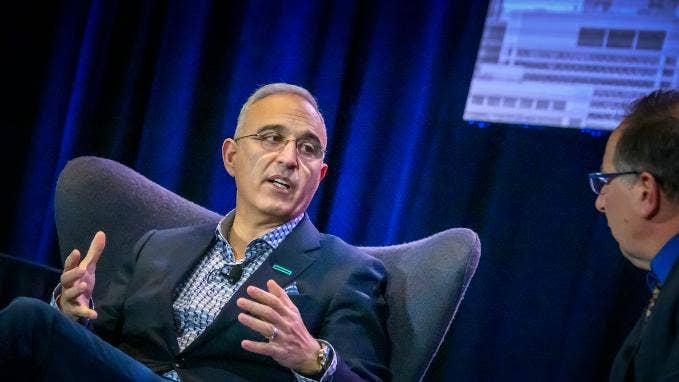
What is your view of AWS Outposts and the difference between how AWS and HPE view hybrid cloud?
First, it is a validation that the world is hybrid. It took them a few years to understand it. Second, they understand that the cloud has to move closer to where the action is. The action is where we live and work. That’s where the majority of the data is created. They understand that the economics associated with that and the need to drive an experience almost in real time requires them to move the cloud closer to where the action is.
To me, Outposts is just a way to continue to lure you to move to the [public] cloud because their ultimate objective is to move your data to the [public] cloud. We have this saying: When you check into the public cloud, it is like checking into the Hotel California. You check in and you never check out. What customers are realizing now is that the cost of egressing that data back is enormous. Enormous.
That is why architecting the right hybrid strategies is fundamentally about the apps and the data. Not all workloads are created equal. When you talk about HPC [high-performance computing] you are talking about very data-intensive workloads. Therefore, the compute and the data have to be co-located. You can’t have the app running on one side and the data on the other side. That is why we have made a bet to become the backbone for the next generation of high-performance computing. With the explosion of data-intensive workloads like AI, machine learning, big data analytics and simulation modeling, we believe we are uniquely positioned to become that backbone. That is why the acquisition of Cray, which we just completed two weeks ago, is foundational. It's not because of the HPC supercomputing but because of the foundational technologies needed both from a software and then the silicon side.
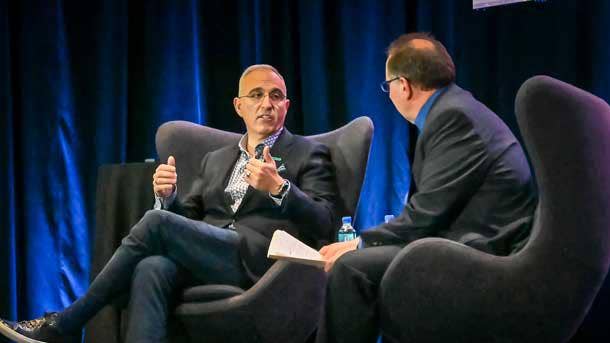
What was the aim of the Cray acquisition?
I think people misunderstood the Cray acquisition a little bit. The reason we bought Cray is they have the foundational technology in the connect fabric in the software stack to manage these data-intensive workloads. That ultimately manifests itself in some sort of HPC cluster and in the future in an Exascale supercomputer. That is one segment of the market, which is going to be a $35 billion market growing at 9 percent. That is a very interesting segment for us to play in.
As I think about our competitors, they want to build a proprietary stack and ultimately help you navigate in that proprietary stack back and forth. We want to give you the flexibility of choice to be in an open environment in a multi-cloud world. Customers used to have one or two vendors—maybe sometimes three vendors—on-prem. The reality is customers are going to have for off-premises more than one vendor, too. They are going to force you to do things in a way that takes a lot of effort and resources.
We want to give you a platform where you run your apps and data where it makes sense—not spending time building things but innovating on that platform.
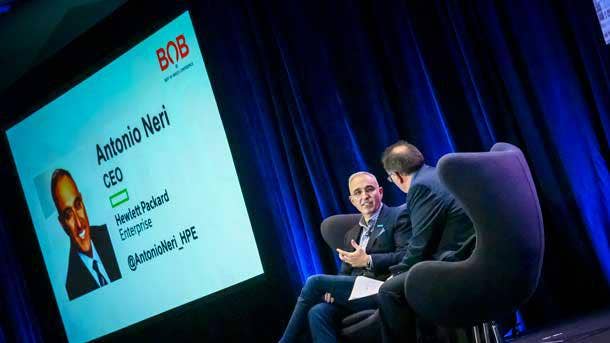
Is Cray going to give solution providers the ability to do more intelligent data management?
Obviously, not many people are in the HPC business. It is a very specialized type of business. But what you should expect from us is to take those technologies which are designed for scale, speed and latency and scale it down into the commercial space. When we do that obviously we can innovate way faster. Also, the margin profiles are better for everybody because Hewlett Packard Enterprise will now own the intellectual property with this new set of capabilities.
Remember, in a workload-centric-optimized approach what is happening is the experience is bifurcated between the silicon and the software, and the system is the way you manifest it. The system can be many things put together in the way that you optimize the whole experience. But the money is ultimately in these two buckets [silicon and software] and wrapped as a service. We are doing more and more silicon. By the way, this company developed more than 60 different kinds of silicon for different purposes, including security. We believe we have the most secure infrastructure on the planet. Think about [HPE] Gen10 servers with [HPE Silicon Root of Trust], Gen11 coming out, all the storage platforms and so forth. What we are delivering is a software-defined experience to deliver that workload-optimized solution in a true open approach and then make it as a service.
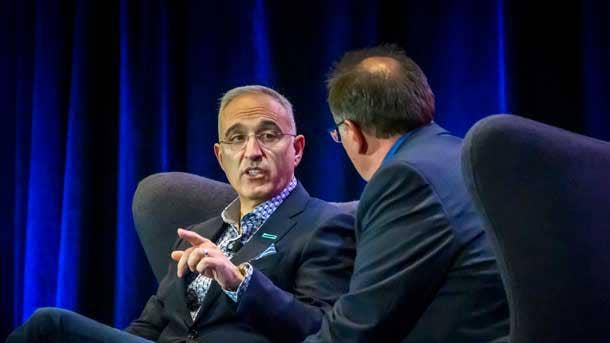
The GreenLake portfolio is expanding rapidly. What can partners expect as you build out this model?
GreenLake is becoming a platform. It’s not just a series of bundles and components. It has to be at the core and experience-driven. I told the team a couple of years ago, I want to have a better experience than procuring services from the cloud, meaning the public cloud. You will see here in the next few weeks an evolution and a radical change in many ways of that platform, where you will be able to procure the as-a-service model in a simple few clicks, ready to provision, enabled by software and then consumption-driven because we have the assets to deliver that at scale. For me, GreenLake is going to become the North Star of how we build our solutions.
What kind of solutions do you envision?
On the edge, the strategy is pretty simple. It starts with connectivity, and we need to provide multiprotocol connectivity for the different use cases. We already have a platform called Aruba. And in that, we are going to lead with an introduction here as you’re going to see in the next couple of weeks, with Aruba Central—which is a cloud platform—where you can subscribe to whatever type of connectivity you need, whether it is LAN, WAN or Wi-Fi.
Next year, we are integrating 5G. So whatever it is, you will have one single experience to provide the right connectivity to the right use case. And also, soon after, we’re going to include the provisioning of edge computing for the same platform because with that comes connectivity, and then comes the processing of the data these devices and the Internet of Things are generating every single day. And we know that the cloud is moving to where the data is created, because physically it is easier and, secondly, it’s cheaper.
The other consideration to understand is compliance, latency and so forth. So Aruba Central is for us the intelligent edge platform for multiprotocol connectivity, edge computing in a secure integrated way, and [it's] autonomous. That’s what our strategy is. If I go to the cloud, and cloud being an experience not a destination, we know the world is hybrid. We have said that. The world is hybrid. In the end, it’s how we help define the right mix of hybrid for our customers through the expertise that both [partners] and we have.
Secondly, it’s how we help customers decide where the data should gravitate because data has a gravitational force. But ultimately, how we provide the best, lowest-cost-optimized solution in a workload-centric approach that’s truly hybrid, data-driven—because we have to build intelligence at the core—in a consumption model. That’s where the power of our HPE Composable platform comes together. So our strategy is to connect these two worlds from edge to cloud in a true as-a-service model with true differentiation at the platform level in terms of connectivity, edge computing, security and analytics—and this is the lowest cost per workload [that is] cloud-enabled, meaning hybrid, with security built at the core in a complete as-a-service model. I think it is the most comprehensive vision and strategy of any of our competitors.
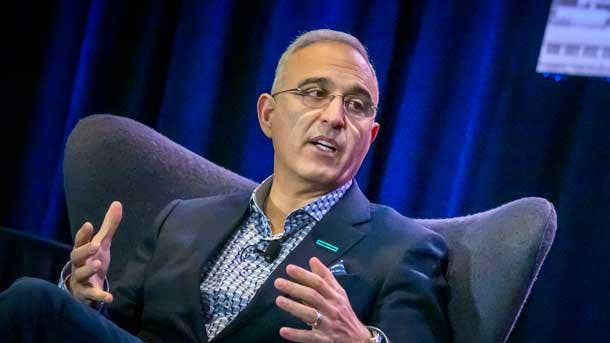
How do your competitors compare?
Dell does not have an intelligent edge strategy and neither does it have an as-a-service strategy. I mean, the fact that you call it Data Center as a Service doesn’t mean you have a consumption model. The consumption model has to be outcome-oriented, application-driven and data-driven. So we think we have a unique point of view, and ultimately we enable you to transition to that model with the elements of self-enablement, confidence and the technical acumen you need these days.
What impact is it going to have, in terms of that lowest cost per workload, on your competitors like AWS public cloud?
Our strategy is to enable you to keep as many workloads as possible on-prem but compete with that experience. It has to be as good an experience as the public cloud experience but delivered as a service. We want to do that in an open environment, a cloud-native environment, autonomously, because that means you don't have to put people running things but can put people toward running innovation on this platform. We do that well with GreenLake, and you can look at the economics. Today we have over 500 partners, many of you are already on GreenLake. The channel growth in the last nine months has been 300 percent. The [Net Promoter Score] is 92 and the renewal rate is 99. Nobody has scaled down. Everybody's scaling up. Once you put the customer on GreenLake, everybody keeps adding because it's an experience, it's not a procurement-driven process. So for us, it is giving you the ability to compete with public cloud, the ability to make more money because the hardware margins associated with GreenLake are higher.
It is a better option for our customers, better economics for both of us and, ultimately, it offers better control of what that transformation truly is for our customers.

Having the lowest cost per workload is such a big statement. A lot of times customers are making that decision and they don't know the real cost of public cloud. Will this put pricing pressure on AWS?
We talk about infrastructure being commoditized. The reality is that the cloud will be commoditized. It's just a matter of time. I think those who have the best economics and the best experience and the agility to move things back and forth will be the winners. And so this is why our point of differentiation is the experience as a service, our point of differentiation is definitely that intelligent edge. That market is four times bigger than the core market.
I think we have the best portfolio in terms of compute, storage and networking in delivering that integrated experience. We want to do it in an open-standard approach, not in a proprietary approach, because customers don't want to be locked in. And we know most of the applications are moving to container-based. So why would I wrap a hypervisor or a VM around a container when you can run on bare metal in a much more economical way?
If you want to move to a true hybrid model, you have to build it to move things back and forth, and we know microservices are much more efficient. So we differentiate ourselves in that ecosystem by these elements, but ultimately it is enabling you, our partners, to satisfy the customer needs in ways that nobody else can because we give you breadth and flexibility and choice.
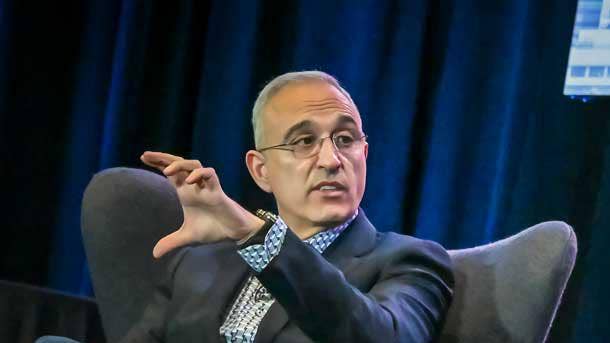
Can you talk a little bit about the intelligent storage story? Primera is out there now, so talk about the intelligence you're bringing to the stack with HPE InfoSight, machine learning and artificial intelligence.
We live in a data-centric [world]. The data era is here. We said two years from now the amount of data will double, but only 6 percent of the data is being utilized. We know when you put data in some sort of infrastructure, that's the single point of failure. What we want to make sure is that we protect the data, we make it compliant and we build intelligence around it so we can extract the valuable insights of the data as quickly as possible. So we have built Primera with that in mind, but with simplicity also, and experience in mind, so HPE Primera is the first intelligent storage platform in which intelligent data management comes into play where we can provide the provisioning of that solution with five cables and six clicks. I call it ‘from rack to app in less than 20 minutes.’
We've got 100 percent data availability because the core of that platform has AI built into it, and we have more than 3 million sensors built into the platform, not just in the storage but all the way to the host, that allows us to monitor and predict issues before they happen. And that's why we are so confident we can give 100 percent availability for our customers. And last on the list, you are now in the business of running infrastructure. Therefore, with one single push of a button you do the entire upgrade in five minutes, which we know has always been a challenge.
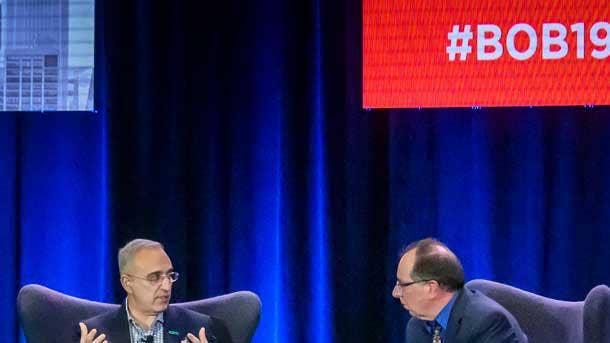
You're coming up on two years in the job. How do you feel about the progress you've made and where you're at right now?
Yeah, time flies. It's almost two years since [former HPE CEO] Meg [Whitman] and I made the transition, and I feel pretty good. I would say I am actually proud of what we have accomplished together with our team and you, our partners. Let me give you a little perspective on what we have done together because I think sometimes we take it for granted. But when I reflect on it, I think it's pretty remarkable. As you recall, when I became the CEO, I said I have three key priorities for myself and the organization.
One is our customers and partners. That's our North Star. That's why we are here. We are here to serve them and to accelerate business outcomes.
Second is to drive innovation, innovation that's customer-driven, and I have to say we made remarkable progress. I feel very proud about the portfolio, which obviously has been evolving over the last couple of years.
And then third is the culture of the company.
But what I'm really pleased about is the fellowship and the momentum that we have with customers and partners, because ultimately our strategy is resonating with them. For us, it is important that we stay focused on that and execute aggressively against what I believe is a massive opportunity for all of us. So I think from the execution perspective, great work, more work to do.
Financially we have done extremely well, which obviously translates for our partners, too. We not only grew the company last year, we expanded profitability quite dramatically, and we had phenomenal shareholder return where the TSR, the total shareholder return, was in excess of 60 percent and [earnings per share] was growing more than 63 percent. So when I think about that, I think, good chapter one, now we need to go write chapter two.
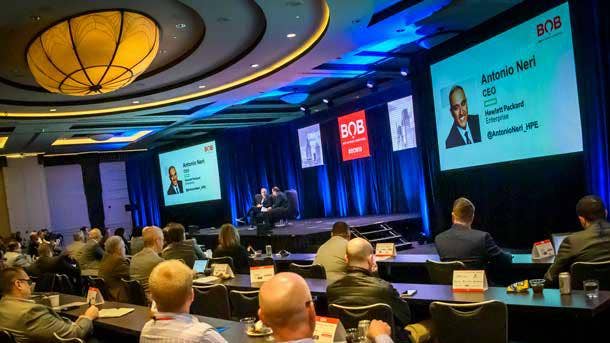
Speaking of chapter two, you made a firm commitment to put all of HPE's products and services into the as-a-service model by 2022. What does that mean for HPE's partners and how much money they can make in the future?
In my first year as CEO, I said the edge is the new frontier, and I believe the edge is going to become the driving force for the enterprise going forward. And we said the future enterprise will be edge-centric, cloud-enabled and data-driven. And this is where we said we are going to invest $4 billion to power that intelligent edge through connectivity, security, analytics and edge computing. And we can talk a little more about where we are on that journey. And second, this year we said that everything we do will be available to our customers and to our partners as a service, and this is where we have a unique point of view and differentiation with the HPE GreenLake platform. When you look at the [total addressable market] today, the TAM is roughly $900 billion between infrastructure, software, services and the public cloud. And $565 billion of that TAM is what we would call outside the public cloud, so more than two-thirds is outside the public cloud. And when you look at that $565 billion, 51 percent is already consumed as a service. That number is going to grow to $685 billion. And the as-a-service portion will grow to 67 percent.
So it is the way customers are going to consume solutions and IT going forward. What they're looking for is an experience, an experience delivered as a solution to them from the edge to the cloud where the data aspect of this becomes the most critical and relevant aspect because the business outcomes are derived from the data.
Our vision is to deliver an edge-to-cloud solution as a service. And we want to be the company that's known to deliver an edge-to-cloud platform as a service, and that's where we are pivoting our investments. Obviously, it starts by having a clear view of the use cases. We want to do it in an open environment, a cloud-native world that's fully automated. That's our strategy.

How has that changed how HPE itself internally approaches developing the products, services and the go-to-market model?
The biggest aspect of the transformation is two-fold. One is on the product management side because obviously the product management has a core function to scan the market, understand the customer challenges and put together a strategy and road map to solve business challenges in a very differentiated way. And always we continue to upskill, reskill, that function because it is probably the most important function inside the business unit.
Second is the go-to-market transformation, and the go-to-market transformation is all about sales enablement. It's all about delivering confidence. This year at the Discover event, we announced as a part of the Global Partner Summit our new programs for the channel and at the core of that is enabling you to drive this transition with us because ultimately the customers are demanding it. If you have to have a different conversation with the customers, you have to have a different way to engage that conversation. So we announced the Sales Pro Academy, which is basically giving you the skill sets, your people, to move those conversations from speeds and feeds to outcomes and outcomes as a service. Obviously, there is the technical aspect of this, the Pro Academy, which is basically how we continue to cultivate and enable the technical community in a solutions-centric approach.
Last but not least is the marketing piece of this, which is the messaging component and how we leverage our digital platform together with our partners to drive the right messaging and ultimately to drive demand generation.
So those are all aspects of what we are doing. I consider your people as a natural extension of my staff; they just happen to carry a different badge. Let's remind ourselves that more than 70 percent of our business is going through the channel. We have been, we are, and we will continue to be a channel-led company, period. Not like some of our competitors who one day they are in and other days they are out. Consistency, trust, predictability matter here. And so that's how culturally we think about it. In many ways, we were channel-ready. Then we moved to be a partner-ready company that's more proactive and now we are basically becoming more a champion of you becoming the heroes in front of our customers.
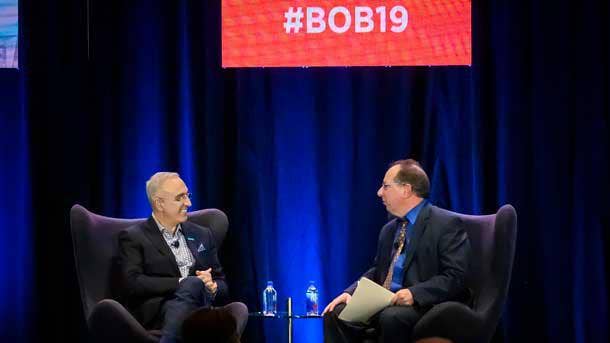
Talk about HPE Aruba and that asset and how important that mobile-cloud-first software is, how that really drives the intelligent edge.
The digital transformation starts by connecting things. Every day, 40 million devices get added to the network around the globe. Think about it—40 million things, it can be a device, it can be a thing—every day and everything computes. The moment it is connected there is some sort of data processing taking place. So when I think about that, you need to have a platform that scales to provide the right connectivity for the right use case.
5G is going to open new use cases, but the reality is that 5G will not solve every problem because— whether it’s cost or whether it’s bandwidth or whether it’s power—the reality is [5G] is not the answer to everything. Wi-Fi is still one-fifth of the cost of the projected 5G costs. So it’s 5 cents per Gigabit versus 1 cent per Gigabit. The opportunity is to integrate 5G and Wi-Fi in this new spectrum to deliver a true private LTE. So that’s where the integration of 5G with Aruba makes complete sense because I can provision that fully integrated experience from the cloud and manage from the cloud as these things scale massively. We already have half a billion devices managed from Aruba Central. So you’re talking about massive scale. That’s why cloud provisioning is important and why multiprotocol is important.
Then you have to do it securely because you can’t think about security after you do this thing.
When you have your cellphone you download the certificate so you can manage the security of that device. When you connect these things—whether it’s a sensor or a firewall—that doesn’t have the ability to drop a certificate. So you have to monitor and understand the behavior and then profile these things. So this is where you go from billions of people and billions of devices to trillion of things. This scalability matters, and security has to be built in the core. Then the third is the analytics part of this. How we take advantage of that connectivity, and security and all the data processes to improve the experience and productivity, whether it’s employees or large enterprises at the edge, or whether it’s in the industrial space, to deliver outcomes faster. In that sense, this is where our opportunity to integrate the edge cloud is unique, because in the end, it will be different types of form factors in terms of a cloud delivery for those specific opportunities. And all this, we are building into the Aruba platform. The thing you will need to sell is only one thing, one thing only: Aruba Central.

So Aruba becomes the fast path to profits for 5G for partners?
It will eventually become a way for you to address the 5G needs of the customer together with the rest
of the connectivity needed. One, interestingly enough, the telcos have a big challenge here: how to transition to a cloud-native world. If more and more applications are developing in a cloud-native world, they are not going follow the traditional way to connect the branch to a data center, and therefore, everything has to go first to the data center and the cloud before you go back to the branch. They’re going to straight to the cloud, and therefore, the software-defined wide-area network becomes the way to provision at scale—way faster, in minutes—any of those branches that need to do business in a cloud-native world. This is where the opportunity for us is to participate in a very large TAM where we drive an integrated experience in a true cloud-native world to power this market called intelligent edge. It’s fascinating.
Listen, we have done some incredible use cases. There is a large food retailer out there that drove this unique experience in a mobile-first, cloud-first approach. You go to the app. You order the food. By the time you get to the store, your food is ready.
Now they are connecting all the machinery—the fryer and the Cokes and everything else—to do predictive analytics on the machinery. They are adding robotics. So when you go to the store drive-thru you are not talking any longer to a person. They see you and recognize you and show you a personalized menu because in the last five visits you asked for these things. They give you that and you say you want A, B or C. And obviously asset management to drive a better, more efficient supply chain becomes part of it.
We have done other use cases like Home Depot. Everybody understands the Home Depot use case with 2,800 stores. We can provision almost 200 stores a night from the cloud. For them, it is about the mobile experience in the store, directing customers where to go get stuff as a way to improve that experience. For them, it is a way to use RFID and other solutions to do inventory management.
How fast is the intelligent edge market developing?
It is accelerating. We already live in an edge-to-cloud world. This edge is becoming more and more relevant. My view is we have a head start on the vision, the strategy and we have a platform that we continue to build around it. For us, it is all about building the use cases and selling it as a solution including the as-a-service component.
Obviously, customers will adopt as-a-service as they go along. More than 60 percent of the market in three years will move to as-a-service whether it is public cloud or the entire edge to on-premise solution will be in that space. We have to lead that in one way or another. We feel pretty good about where we are. We just need to do it faster.

How do you get away from the pressure to sit back and think and make sure that HPE isn't missing something as you build this whole thing out?
It starts with having clarity about what you want to do, and that clarity comes by spending time with [our partners] and our customers. I don't sit in my office making stuff up. I spend 50 percent of my time with customers, traveling. When you talk to customers, generally you are going to get the truth.
Second is by having a strong team, and I have to say I have assembled a very strong team now that is passionate about competing and winning, and ultimately serving our customers and partners better than anybody else. And so when you look at my executive team, they have been handpicked by me over the last 18 months. Some of them are in new positions, or some of them have a unique set of skills, but it is a very diverse team in terms of experience and what they have done, so that sets you up for some strong debates. I could've gone the other way, I could pick people I can manage and do whatever I want, but I value the power of diversity and people who can push you to think about things differently. When dialogue takes place and debate takes place, normally you tend to come up with a better solution. And so that's what we have done.

Tell us about sports partnerships that HPE has worked on, including the Mercedes-AMG Petronas Motorsport partnership?
We are proud of the partnerships we have in sports. They actually push you to be in the forefront of innovation. In the case of the Golden State Warriors’ Chase Center, which just opened, we implemented the entire wireless connectivity for the stadium including IoT. So when you go to that stadium to watch a game or concert, you will see a whole different experience. It’s an incredible digital venue that they will be monetizing by offering you services.
The Tottenham Hotspur soccer stadium [we worked on] is the first true digital stadium where everything is delivered in a mobile- cloud-first approach and everything is connected to the network from ticketing to point of sales to cameras to broadcasting. Everything is HPE Aruba.
Formula 1 is probably the most advanced sport when it comes down to technology. For us, it was kind of a playground to test innovation. And obviously on the other side you need to have a group of people and a leader who values innovation. In this case Toto Wolff, the team director and part owner, is incredibly competitive, as I am. He understood in order for him to stay ahead and compete and win he needs to put the drivers in a position to drive faster. Technology plays a huge role. Our HPE technology serves three purposes—one is to help design the car. When you go to how they design the car and the wind tunnel, the back end of the infrastructure is Hewlett Packard Enterprise. No. 2 is to empower the drivers with the best data. So the entire AI machinery that the drivers use for defining how they are going to drive is Hewlett Packard Enterprise. No. 3 is the strategy for the race: So the entire AI stack is running on Hewlett Packard Enterprise. Every race has multiple data points—the weather, the track, the tires. They pool all the data and ingest it. It used to take them 12 hours to analyze that between qualifying and the race. Now they can do it in less than an hour so they can run multiple simulations.
They take that technology as the Mercedes team and they cascade that into Daimler. Daimler is the company that you buy Mercedes cars from. For us, it was an entrée to get into that bigger mass commercial market.
You worked with three-time Formula One world champion Niki Lauda—the non-executive chairman of Mercedes Benz Grand Prix Ltd—who just passed away. What was he like?
Niki was an incredible leader—a sportsman, a gentleman, but he was a businessman. It was unbelievable. I remember being at a few races with him in part of the strategy meetings with him, [Mercedes Team Principal and CEO] Toto [Wolff] and the two drivers talking about how they were going to race. He was a force of nature and an incredible human being who obviously went through a lot in his life in terms of accidents and life challenges. But he was an incredible luminary in terms of driving the business. He built something unique. He is not only a legend as a driver but also an incredible businessman who made Mercedes together with Toto a force of nature. Winning six titles is unbelievable.

You're super-competitive and I know you have this saying, which is that if you can't win, at least get into a fight and have some fun. Where does that come from?
Well, I think it comes from how you grew up. I grew up both between Argentina and Italy, but a big chunk of my time as a teenager was spent in Argentina playing soccer. And for those who understand soccer, it's very intense in Argentina, and so we have a unique set of cultural values and when you cross that line and enter the field, you are a whole different person. You don't have to say anything. People react the same way, so we go to play and to win, but if you're not going to win, we'll pick a fight so at least we have some fun.
Is there an area of the industry that you want to be more dominant in, like security?
I think we have a lot of our own intellectual property because we think about building security at the core, not as an afterthought. We talk about Silicon Root of Trust and iLO [Integrated Lights Out] built at the infrastructure level or at the edge with Niara, ClearPass and others in a more behavioral level. But as we think about the future and how we build a solution, we think about building the security within the stack itself.
Obviously, we are looking for an opportunity to accelerate that innovation through acquisition and partnerships. Innovation comes in three forms: organically and, by the way, we have made the bet to invest $4 billion at the edge. That is an organic investment over four years. We are making huge investments in the GreenLake platform.
But also we are making investments inorganically. In the last 18 months I have done seven acquisitions starting with Plexxi and closing with Cray and all of them come with different types of solutions. The scaling of that in our portfolio and, most importantly, to our go-to-market with you as partners is super critical. But we want to give you a solution, not a bag of doorknobs you have to put together because that is not what customers are going to buy.
Then there’s the partnership ecosystem. We have a very broad partner ecosystem. Some companies will not even think about that. Particularly as you move into the industrial side of the house, we have partnerships now that are part of our solutions: ABB, Schneider Electric and others. Tomorrow we are going to talk about something new, so stay tuned.

As you look at the HPE acquisitions–15 over the last two and a half years– how many more puzzle pieces are there to put in there and what is the picture going to look like?
As I said, the innovation comes in three forms [organic, partnerships and acquisitions]. Obviously from a shareholder perspective, they want to know you are investing dollars wisely and you are not doing anything stupid.
We have a very stringent return on invested capital. But if we have conviction that a particular asset is incredibly strategic to us, we will pursue it. The Cray acquisition is a great example. So is Aruba.
Because of the transformation we drove in the last seven years it gives us the ability to move faster, to allocate capital in a better way and ultimately to be much more refined in where we play and how we win versus just buying stuff that does not come together. For us, driving that experience in that architecture that is open is important and then, where it makes sense, we will pursue it.
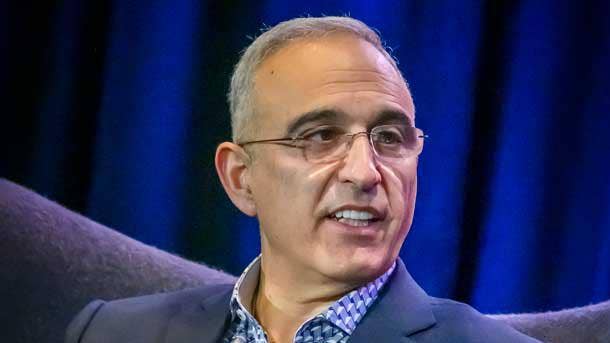
HPE made a decision to get out of the tier-one hyper-scale server market and not focus on server share for share’s sake. How has that translated into partners’ ability to make money?
We made that decision because there was no money to be made [in the tier-one hyper-scale server market]. It was very distracting. It was taking a lot of energy and time from our R&D team. Ultimately, it was not a long-term value creation for our shareholders. At its peak, we used to have almost $2 billion of our revenue selling through the tier-one business—call it the Super 10. So it was more than 50 percent of our compute revenue. So we decided to work it off. Now it is almost negligible. We transitioned the portfolio. We knew for those enterprise customers what they wanted was software- defined solutions that ultimately bring them a hybrid world and ultimately delivered as a service.
That is why it has been a journey to pivot what I call the commoditized business into more of a value business. What we see is the customers and our partners adopting what I call blocks of IT.
What they want is ‘Give me a solution out to the box that can run my apps and data so I can innovate faster.’ That has resulted in a significant margin improvement. We have three businesses: intelligent edge, hybrid IT and HPE Financial Services, which I think is a core component I think our partners should leverage more.
In the end, our hybrid IT business has improved margins in excess of 600 basis points by taking costs out and by pivoting the portfolio.
At the same time, we have invested more. We have invested a significant amount of dollars on our go-to-market. A big chunk of dollars goes through the channel, obviously, and at the same time more dollars in R&D. If you look at our last earnings on our investor relations site, look at the [slide] deck: There is a slide that shows our Opex for R&D as a percent of revenue. In the last seven quarters that has continued to grow. Our profitability was 7 percent operating margins in Q1 2018. In Q3 2018, we exited the quarter at 10 percent.
So the pivot is there. The growth in strategic categories is there. The acceleration in as a service is there. We just need to do it in a more integrated-edge-to-cloud manner, keep driving that customer-driven innovation and continue to build the portfolio together with you.